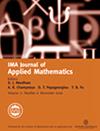用渐近匹配估计保形容量
IF 1.4
4区 数学
Q2 MATHEMATICS, APPLIED
引用次数: 0
摘要
保角容量是一个与广泛的物理和数学问题相关的数学量,最近人们对设计新的计算方法重新产生了兴趣。在本文中,我们展示了如何使用匹配渐近线的思想来导出保角容量的估计。这里推导的公式是明确的,有证据表明,即使在预期的有效范围之外,它们也能提供精确容量值的极好近似值。本文章由计算机程序翻译,如有差异,请以英文原文为准。
Estimating conformal capacity using asymptotic matching
Conformal capacity is a mathematical quantity relevant to a wide range of physical and mathematical problems and recently there has been a resurgence of interest in devising new methods for its computation. In this paper we show how ideas from matched asymptotics can be used to derive estimates for conformal capacity. The formulas derived here are explicit, and there is evidence that they provide excellent approximations to the exact capacity values even well outside the expected range of validity.
求助全文
通过发布文献求助,成功后即可免费获取论文全文。
去求助
来源期刊
CiteScore
2.30
自引率
8.30%
发文量
32
审稿时长
24 months
期刊介绍:
The IMA Journal of Applied Mathematics is a direct successor of the Journal of the Institute of Mathematics and its Applications which was started in 1965. It is an interdisciplinary journal that publishes research on mathematics arising in the physical sciences and engineering as well as suitable articles in the life sciences, social sciences, and finance. Submissions should address interesting and challenging mathematical problems arising in applications. A good balance between the development of the application(s) and the analysis is expected. Papers that either use established methods to address solved problems or that present analysis in the absence of applications will not be considered.
The journal welcomes submissions in many research areas. Examples are: continuum mechanics materials science and elasticity, including boundary layer theory, combustion, complex flows and soft matter, electrohydrodynamics and magnetohydrodynamics, geophysical flows, granular flows, interfacial and free surface flows, vortex dynamics; elasticity theory; linear and nonlinear wave propagation, nonlinear optics and photonics; inverse problems; applied dynamical systems and nonlinear systems; mathematical physics; stochastic differential equations and stochastic dynamics; network science; industrial applications.

 求助内容:
求助内容: 应助结果提醒方式:
应助结果提醒方式:


